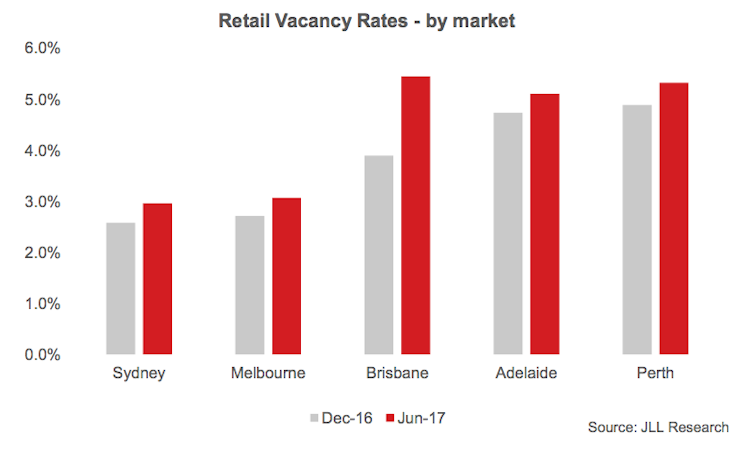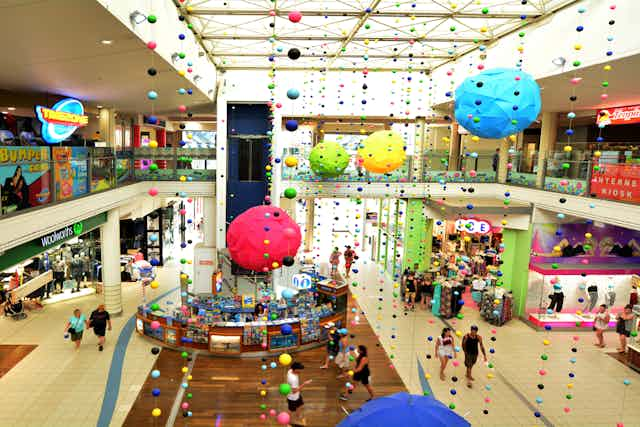Even before the arrival of Amazon, online shopping is devastating Australian retail. In the past year, sales in physical stores grew only 3% while online shopping grew almost 10%. Foot traffic in physical stores has fallen by almost 5% this year alone.
Both retailers and shopping centre operators have to work together to create compelling reasons for customers to leave their homes and go shopping in physical stores. This has already resulted in a lot of experimentation, from VIP shopping nights to pop-up stores and events.
As the likes of Amazon enter Australia, shopping centres and retailers are going to need to be extra creative.
The decline in foot traffic is reflected in the retail industry’s profit margins, which have consistently declined since 2008-09. Physical stores have seen their profit margins hover around 5% since 2008-09, while online retailers’ have grown. Profit margins for online retailers are now roughly double that of bricks-and-mortar stores.
All of this is causing tensions between retailers and shopping centres as customers increasingly shop online.
Read more: Amazon poses a double threat to Australian retailers
This year alone, major retailers like Payless Shoes, Topshop, David Lawrence and Rhodes & Beckett have entered administration.
Even big retailers aren’t being spared, with Myer reducing its profit forecasts off the back of “continued weakness in retail trading conditions”.
The pressure on retailers is flowing through to shopping centre operators. Data show increasing vacancies in retail spaces in major cities across the country, but most notably in Brisbane, Adelaide and Perth.

Shopping centres and retailers need to work together
Some shopping centre operators are responding by expanding their offerings of food, events and experiences. For example, the redevelopment of the Chadstone shopping centre in Victoria included a new dine-in restaurant precinct, an up-market movie theatre and a Lego Discovery Centre.
However, these changes are not always received positively by existing occupants. Food chain SumoSalad has put some stores in voluntary administration over a dispute with Westfield. SumoSalad accused the shopping centre chain of cannibalising its business by allowing competitors to open in newly created food courts.
The Franchise Council of Australia has even warned that retailers could move to strip malls if shopping centre operators continue to open new stores and food courts within existing complexes.
For the past five years, a team at Monash Business School have surveyed Australian retailers to find their perceptions of, and satisfaction with, the top Australian shopping centre operators.
The survey has some good news – shopping centre operators are improving in the eyes of retailers. Despite the challenges of decreased footfall and slowing turnover growth, retailer ratings of the performance of their shopping centre landlords have steadily improved over the past five years. And 2017 was the first year when more retailers rated their landlords positively than negatively.
The survey also shows retailers’ expectations are changing. Of course, retailers would like lower rents, but this has become less important over time. Retailers now put more weight on the marketing and other support that landlords can provide to encourage more foot traffic.
Retailers want shopping centre operators to create innovative marketing campaigns to encourage consumers to visit their particular centre. For example, one Melbourne shopping centre has started hosting “VIP” nights that include DJs, pop-up bars and even free transport.
Pop-up activations and in-centre events can also be used to highlight local or unique brands that can’t be found online, thereby drawing customers back to physical stores. 100 Squared, for example, is a pop-up retail showcase of local designers in major shopping centres across Australia.
Retailers also want more information and analysis on foot traffic and marketing effectiveness. This includes data on shopper traffic and demographics, customer segmentation and transactions data. Using this information, retailers can tailor marketing events and activities to the local market.
Through a collaborative approach, there is an opportunity for both retailers and landlords to weather the storm. Many centres are now making space available for short-term, flexible leases to encourage emerging brands to showcase their stock through pop-up stores. Others are focused on the local community, providing additional community services to become a new-age form of a town centre.
Retailers and shopping centre operators both need this type of collaboration to survive, and even thrive, as online shopping continues to grow. This will not only improve foot traffic and revenues, but also provide consumers with unique and hopefully enjoyable shopping experiences.

